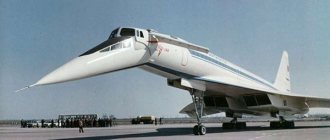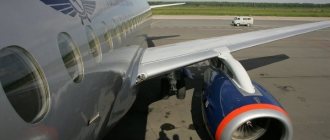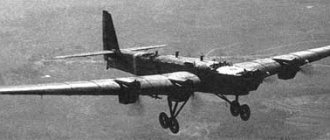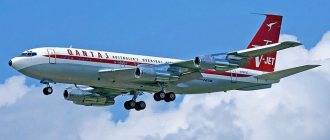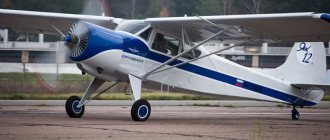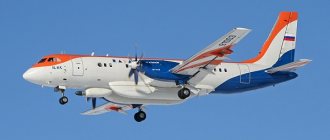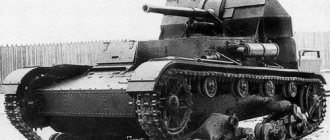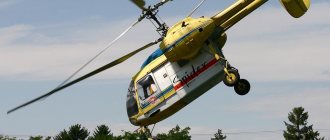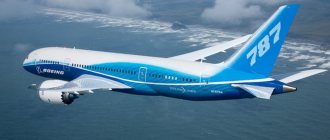The Tu 22 M3 is a strategic multi-mode supersonic missile carrier - a bomber designed to hit targets on enemy territory, which is a deeply modernized version of the TU 22M2 with significantly expanded combat and defensive capabilities. Machine development by OKB A.N. Tupolev has been under development since 1974, and the first test flight took place on June 20, 1977. The vehicle entered service with the Air Force in 1978 and was produced until 1993 by the Kazan Aviation Production Association (KAPO). The production of TU 22 M3 was limited by the agreement on the reduction of strategic offensive weapons SALT-2 and over the entire period 268 units of equipment were produced.
Tu-22 M3 photo
In terms of technical characteristics, the machine is significantly superior to its foreign analogues. The practical range of the TU 22M3 is 7 thousand km, the cruising speed is 930 km/h, the maximum is 2300 km/h, the maximum lifting weight of the vehicle can be 124 tons. The main design features of the aircraft are the geometric variability of the wing, an all-moving stabilizer and a vertical single-fin tail made of aluminum alloys. The wing consists of rotating consoles, which can take on sweep angle values, depending on the speed, 200, 300 and 650, and a fixed solid part.
The wing pivot units are protected by aerodynamic ridges, which help protect the consoles from air flow. Due to the deflectable horizontal tail, it is possible to duplicate the lateral controls in the event of emergency situations associated with their failure.
History of the Tu-22M3 design
The Tu-22M3 was one of the further modifications in the Tu-22 M line. The creation of new aircraft was dictated by the need for lighter, faster and more multifunctional bombers to appear in military aviation. Changes were to affect the design of the wings, engines and attack and defense systems.
At the beginning of 1974, a decision was made to create the Tu-22M3. It was planned to introduce modern engines in the new launch vehicle, reduce take-off weight, improve the on-board system and design a new sighting system. The car received a number of transformations:
- New electronically controlled engines.
- The air intakes were separated from the wings, which made it possible to increase flight speed.
- Completely updated electrical system.
- New elements of the onboard defense complex.
- General reconstruction of the aircraft hull and parts.
Since 1977, production of the Tu-22M3 began. In the next two years, after a set of tests, the model completely replaces the previous version of the Tu-22M2. The final version of the finished aircraft carrier was adopted in the late 1980s. In 1993, production of this series of equipment was completed. The last copy, due to the customer's inability to pay, was turned into a monument. In total, over the years of the model’s existence, 268 units of equipment under this name came off the assembly line.
Some of the aircraft (70 aircraft) were under the control of the Russian Air Force. More than 80 more belonged to the Navy, which in 2011 transferred the bombers available in good condition to the disposal of the Air Force of the Russian Federation.
Currently, there are projects to use and develop this model. Further modifications are being developed, including export variations. The implementation plans include an ambitious project to use the Tu-22M3 to launch small satellites directly into orbit. This will significantly increase the economic efficiency of introducing small satellites into orbit, reducing its cost by 20-30%.
Complexes of work to improve the Tu-22M suggest extending its service life by 40 years with the introduction of improved design features.
Tu-22 M3 photo
The aircraft is equipped with two NK-25 turbojet engines, developing power with an afterburner of up to 25 thousand kgf. The power plant is controlled by the ESD-25 electrical system, and in the event of its failure, a backup hydromechanical system is provided. The aircraft's internal tanks with a total capacity of 50 thousand liters are located in the fin, center section, in the movable and fixed parts of the wing and the central part of the fuselage.
Operation and export
At different periods of the bomber's service, there were reports of the possible export of the Tu-22M3 to other countries, but most of them do not have official confirmation. Iran planned to purchase seven pieces of equipment to conduct air missions in the context of a brewing military-political conflict. The Russian government denied this information.
In 2013, information about China’s purchase of twenty-five aircraft was leaked online, which also did not receive precise confirmation. Prior to this, negotiations were held on the supply of cars to India, as well as the provision of several copies on lease. However, for various reasons, the solutions were not translated into reality.
During the years of their existence from the moment of launch, Tu-22M3 bombers were located in various cities of the USSR, Russia and the CIS countries. After the collapse of the Soviet Union, the equipment was recalled from Belarus to Russia. In Ukraine, the cars were used until 2003-2006, after which they were destroyed. One copy of the Tu-22M3 is in the museum as an exhibit. Today, working aircraft are deployed in the Kaluga, Murmansk, Ryazan and Irkutsk regions.
Currently, there are 62 Tu-22M3 units on the move in Russia. Some of the equipment is currently decommissioned or is in storage.
The aircraft is of great strategic importance in the development of the defense complex of the Russian Federation. Its unsurpassed characteristics allow it to maintain the advantage of its state's military aviation.
Tu-22 M3 cabin
The TU22M3 on-board equipment consists of a navigation and flight control system that allows the aircraft to automatically fly along a predetermined route, a radar targeting and navigation system, and electronic radar equipment with the help of which radar reconnaissance, jamming, warning of radar exposure, ejection of heat traps and reflectors are carried out. , an IR station designed to notify the crew of the approach of enemy missiles.
Re-equipment 2017-2020
Instead of the X-22, the X-32 with protection against radio interference was adopted in 2016. Instead of the Kh-55 and Kh-555, the Kh-101 and Kh-102 appeared, and in the future, Zircon hypersonic missiles. Impeccable bombing accuracy is ensured by the 2012 SVP-24-22 sighting and computing system, which allows you to use even WWII bombs with the same result. The Tu-22M3 is changing its on-board radar and monitors, and is armed with the latest generation of electronic warfare.
PS Of the 268 Tu-22M3 built, no more than 170 aircraft remain, of which today 30 are in service in the Russian Federation, which are being modernized as planned by 2020, the rest, forgotten, will be able to fly only after complete restoration, and not all of them.
Tu-22 M3 diagram
The aircraft's combat equipment may include: three supersonic air-to-ground missiles, ten aeroballistic missiles for hitting enemy ground targets, as well as up to 12 tons of conventional or nuclear bombs located in the fuselage and on the external sling. The aircraft is also equipped with defensive weapons - a GSh-23 cannon with a rate of fire of up to 4 thousand rounds per minute. The TU 22 M3 is still in Russian service. In 2008, the aircraft successfully carried out combat missions during the war in South Ossetia, carrying out targeted air strikes on enemy bases and ammunition depots.
History of creation
Immediately after the end of World War II, nuclear weapons were created. Over time, the question arose about how to deliver it to enemy territory. Thus began the famous arms race of the Cold War.
Two warring parties, the flagships of that time in the field of military developments - the USA and the USSR, laid the foundation for strategic aviation.
At first, the Soviet side noticeably lagged behind their American counterparts. The very creation of man's deadliest weapon, the nuclear bomb, happened later than in the United States. The weapon delivery vehicle used in the Union was the Tu-4 long-range bomber.
In fact, it was a copy of the American B-29 bomber.
But these aircraft were practically unable to effectively carry out strategic missions. The piston engines used could not provide high flight speed, and the relatively short range of non-stop operation did not guarantee a 100% possibility of delivering a nuclear strike on enemy territory.
But technology developed, and soon made it possible to take a big step in the development of strategic aviation. Already in the 50s of the 20th century, “strategists” reached and overcame the speed of sound.
In those days, supersonic flight at high altitude guaranteed the completion of all combat missions. Neither country's air defense systems had the capabilities to destroy such objects. And, this meant an almost 100% probability of delivery of weapons of mass destruction and a lost war.
The USSR responded to the successful models of the American Air Force: B-58 and carrier-based A-5 “Vigilent” with Myasishchev and Tupolev strategic bombers: M-50 and Tu-22.
The creation of multi-mode supersonic bombers required designers to introduce new technologies, materials and often revolutionary solutions into the aircraft industry.
The aircraft designed at that time have long since gone down in history, but nevertheless, it was on their basis and experience that modern aircraft were created that took their rightful places in the “nuclear triad.”
The life countdown for the Tu-22 aircraft began in 1954. The brilliant designer Andrei Nikolaevich Tupolev immediately developed two projects for qualitative improvement of the Tu-16 bombers existing at that time.
During the analysis and long discussions, the Tu-22 variant was chosen, which took off for the first time in 1958. The plane had a classic layout, with a rather interesting, but nevertheless somewhat unsuccessful at that time engine placement.
They were installed on top of the fuselage, in the rear of the aircraft, directly under the fin. This arrangement created problems in the future, during operation at combat airfields. The Kazan Aviation Plant began production of the new aircraft.
During the tests of the Tu-22, it turned out that not everything went smoothly. The bomber did not produce the predicted results for maximum speed and flight range. Thus, the flight speed was up to 1450 km/h, although it was originally planned to reach 1500-1600 km/h. The flight range was also lower than predicted.
Despite the shortcomings, the Tu-22 continues to be improved, and in 1962 they begin to be delivered to long-range aviation combat units for service.
The adoption of the Tu-22 into service in economic terms made a fairly large hole in the budget of the Ministry of Defense. The landing and takeoff modes of the new bomber required the reconstruction of some strategic aviation airfields, since landing the Tu-22 required at least 3 kilometers of runway.
But all these shortcomings pale in comparison with the main disadvantage of the car. From the very beginning of test flights, it became clear that the Tu-22 suffered accident after accident due to equipment and instrument failures, as well as various breakdowns and malfunctions.
There are statistics according to which more than 70 vehicles were lost before 1975. For comparison, until 1990, 311 cars were manufactured. It turns out that about 20% of them had emergency landings.
They were able to modify the car and get rid of frequent failures only by the 1970s of the twentieth century. But even after the accident they continued, albeit in smaller quantities.
The Tu-22 has received a bad reputation as one of the most unreliable aircraft in the history of Russian aviation. There were known cases when pilots simply refused to take off on this plane.
But such failures were associated not only with a high accident rate, but also with the great complexity of the aircraft to control. The Tu-22 crew did not include a co-pilot and a navigator, which was not the best solution for such heavy vehicles.
The already difficult management was made even more stressful by the additional responsibilities assigned to each crew member. In reality, only first class pilots could fly such aircraft.
The Tu-22 was distinguished by its high takeoff and landing speed.
At that time, there was not a single effective simulator on which these important processes could be worked out. Therefore, the introduction of vehicles into the troops was accompanied by frequent accidents. People died, airfields and equipment were damaged.
High speeds during landing carried a very large load on the landing gear. It is known that there were cases when one of the wheel struts folded, and the ADD lost both the aircraft and the trained crew.
The ergonomics of the cabin were also far from perfect. Many levers and toggle switches were located so far away that they had to be reached, and the frequency of their use was often very high.
As a result, the crew members got tired quite quickly during a long flight, and their attention was dulled, which also negatively affected the accident rate of the vehicle.
The poorly positioned engines received a lot of criticism. At high speeds, the car often lost control and became uncontrollable. During the flight, the skin of the aircraft became very hot and deformed due to very high temperatures.
To all this we can add very great difficulties with servicing the bomber. The flight required lengthy preparation, which normally took 3.5 hours.
And the preliminary preparation of all aircraft systems could take a whole working day. The engines were located at a very high altitude, so any breakdown took longer to repair than on other aircraft.
But all these numerous mistakes made it possible to create a fundamentally new machine, the Tu-22M. Despite the similar name, the new aircraft was very different from its predecessor. The developers took into account many of the inconveniences and changed the design of the aircraft in such a way as to make one of the best examples of strategic aviation in the world.
TU-22 M3 characteristics
| Modification | Tu-22M3 |
| Wingspan, m | |
| maximum (65 degrees) | 34.28 |
| minimum (20 degrees) | 23.30 |
| Length, m | 41.46 |
| Height, m | 11.05 |
| Wing area, m2 | |
| maximum (65 degrees) | 183.57 |
| minimum (20 degrees) | 175.80 |
| Weight, kg | |
| empty | 78000 |
| normal takeoff | 112000 |
| maximum takeoff | 126000 |
| Fuel weight, kg | 53550 |
| engine's type | 2 DTRDF NK-25 |
| Thrust, kgf | |
| afterburner | 2 x 14500 |
| afterburner | 2 x 25000 |
| Maximum speed, km/h | |
| on high | 2300 |
| near the ground | 1050 |
| Cruising speed, km/h | 930 |
| Practical range, km | 7000 |
| Combat radius, km | |
| at supersonic speed | 1500-1850 |
| at subsonic speed near the ground | 1500-1650 |
| at subsonic speed along a mixed profile | 2410 |
| Practical ceiling, m | 13300 |
| Crew, people | 4 |
| Weapons: | one 23-mm gun GSh-23L |
| combat load - 24000 kg (maximum) and | |
| 12000 kg (normal) | |
| 1-3 UR type X-22M | |
| 10 X-15 aeroballistic missiles |
Interesting Facts
- During the Cold War, aircraft carriers of NATO countries were most afraid of Tu-22 ; it was not for nothing that they were nicknamed “aircraft carrier killers.”
- During the hostilities in Afghanistan, Tu-22M3s were used to a limited extent at the very end of the war during the withdrawal of troops.
- On the territory of Chechnya, the Tu-22M3 participated in individual operations to more accurately guide attack aircraft to the target using OSAB.
Tu-22
- In the Georgian-Ossetian conflict of 2008, Tu-22M3 destroyed manpower and bombed warehouses and airfields located in the Kodori Gorge.
- After the Tu-22M3 , the command decided not to use these aircraft anymore.
- In November 2015, fourteen Tu-22M3 took part in the combat operations of the Russian Aerospace Forces in Syrian airspace.
- The Tu-22M3 took part in the filming of the film “Peculiarities of the National Hunt”, and in the film “All the Fears of the World” there is a plot of the attack of this aircraft on an aircraft carrier.
Tu-22
Tu-22M, supersonic bomber
The control system is dual, electrohydromechanical, differential, with four control channels: for heading - rudder, for roll - spoilers, for pitch - stabilizer and a reserve channel of the differential stabilizer (differential roll stabilizer).
The pilots' movements of the column and pedals are transmitted through mechanical tubular rods through differential rockers to power hydraulic steering actuators (boosters), which synchronously deflect the halves of the stabilizer and the rudder. Also connected to the differential rockers are the ABSU steering units, which, depending on the automation control signals, add (or reduce) deviations of the control surfaces, depending on the flight modes, or take over control entirely - in fact, all body movements of the pilots are monitored, and, if necessary, are corrected automatically quite strictly. Due to the almost complete absence of effort on the column and pedals, flight/takeoff and landing load simulators - spring loaders - have been introduced into the control wiring. The pitch channel has an electromechanical automatic column flow limiter - a torsion bar. An electrically remote four-channel control system (EDCS) is installed in the roll channel, without mechanical wiring, two steering drives of which control the operation of the power hydraulic drives of the interceptors. To reserve it, a roll channel on the stabilizer with its own steering unit is used, which allows you to control the aircraft in roll by differential deflection of the stabilizer halves. The yaw, roll and pitch control wiring also includes electric trim mechanisms (trimming effect, auto trim in the pitch channel), and an electric mechanism for the automatic balancing system in the pitch channel.
When parked, due to the lack of pressure in the hydraulic system, the stabilizer lowers its toes until the hydraulic cylinders stop - it goes into pitching position.
Wing.
The wing technologically consists of a rotating part of the PCHK, a middle part of the SCHK, a rotating unit, and a center section. The center section and the SCHK are inextricably connected to each other and together form the central part of the wing, and the center section is essentially a power element of the structure (and the fuel tank-compartment of negative overloads, tank No. 4K). The load-bearing power parts of the center section, SCHK and PCHK have a caisson structure formed by spars, monolithic pressed panels and sealed ribs at the ends and are fuel tanks.
The middle part of the wing has a sweep of 56° along the leading edge and 0° along the trailing edge. The rotating part of the wing is set to the takeoff and landing position along the leading edge X = 20°, and only with this sweep is it possible to extend the flaps (takeoff position of the flaps - 23°, landing - 40°, or any intermediate - if necessary). The PCHK in the 30° position is used at subsonic speeds, from flight near the airfield to cruising modes. Sweep of more than 30° up to 65° is used at transonic and supersonic speeds. The flaps are double-slotted, three-section, with a hydraulic screw drive from a two-channel hydraulic motor installed on the ceiling of the cargo compartment. The wing rotation control system is almost identical to the flap control system (similar to the Su-24), the drive is carried out by a two-channel hydraulic motor on the rear wall of the t/compartment 33 frame. The control units SPK and SPZ are installed in the compartment of the front landing gear niche. The PCHK is attached to the SCHK with hinged rotary units. The consoles have a geometric negative conical twist of −4° to prevent stall at high angles of attack and expand the range of operational flight speeds. The slats, installed along the leading edge of the front wing and circuit-synchronized with the flaps, are automatically extended by electric drive mechanisms before the flaps are extended and are also retracted automatically immediately after the flaps are fully retracted.
The wing hinge assembly provides angular movement of the rotating part of the wing - the PChK relative to the middle part of the SChK wing, and also secures the PChK to the SChK. This node absorbs all loads acting on the PFC: bending, torsion, shear. In addition to its main purpose, the hinge unit serves as a transition unit for electrical wiring, hydraulic systems, flap transmission, fuel and drainage pipelines.
Due to the sad operating experience of the first Tu-22, where ailerons with mechanical wiring were used, and due to the heating of the skin, significant deformation of the control rods occurred, for the main control of the Tu-22M2/3 aircraft in roll, a four-channel system of electrically remote control of spoilers DUI-2M is used . Interceptors are installed on each wing plane and are moved by blocks of BGC-10 hydraulic cylinders, which, in turn, are controlled by four-channel steering units RA-57. Interceptors are also used as brake flaps in flight and on landing, and they can be synchronously released to any operating angle, up to a maximum deflection angle of 45°, and at the same time their differential deflection is maintained to control the roll of the aircraft. The use of spoilers instead of ailerons reduces the “twist” of the wing when M is more than 1 and structurally frees the trailing edge for the installation of highly effective large-area flaps.
Plumage.
The stabilizer is a caisson design with two spars, swept-back in plan - it has a sweep angle along the leading edge of 59 degrees and a transverse V = +8 degrees. It consists of two halves, mounted on the left and right on the fuselage supports, which are connected by a differential mixer, which ensures that the stabilizer operates both in the main elevator mode and in the reserve aileron mode. The stabilizer halves have a reverse lift profile. Both halves are structurally completely similar, but the “leading” half, from which the automation operates and on which all measurements of angular movements are performed, is considered the right half.
On an airplane, to ensure directional stability at high speeds, a developed keel is used, structurally consisting of an upper part, a lower part, a foril, a keel superstructure and a rudder. The latter has weight rebalancing and axial aerodynamic compensation of 25% of its area. The lower part of the keel is a caisson tank No. 9. The forkeel, in addition to increasing directional stability, serves to accommodate various equipment, units and electronic units, including the TA-6A APU. The aft part of the keel consists of the upper fairing of the video camera of the TP-1KM telesight, the middle radio-transparent (made of fiberglass) fairing of the Krypton radar antenna and the lower fairing of the Unified Aft Installation (UKU) with the GSh-23M cannon.
A characteristic design feature of Tu-22M aircraft is the rudder “zero” shifted to the left by 2-3 degrees to compensate for engine torque.
Instrumentation equipment.
The Tu-22M aircraft is distinguished by a very high density of the cabin - instruments, toggle switches and signal displays are installed on instrument panels, side panels, upper panels, ceiling panels (inter-canopy beams), rear panels of the air defense system and middle consoles (between the seats). Some of the monitoring and control equipment is located underground in the cabin (gas station, gas station and additional PNA screen), technical compartments and cargo compartment.
The cockpit instrumentation consists of traditional dial gauges. The main flight and navigation instruments are the flight command PKP-72 on the pilots’ dashboards and the navigation plan PNP-72 for the pilots and navigator, from the set of the Bort-45 trajectory control system. PKP-72 and PNP-72 have a “view from the plane to the ground” indication. Reserve attitude indicator type AGR-72, angle of attack and overload indicator from the AUASP-34KR kit, direction indicator type EUP-53MK. Speed and altitude indicators are from the TsSV-3M-1K kit; additionally installed: speed indicator KUS-2500, altimeters UVID-90 and VD-20. Indicators for fuel, moving parts of the control and mechanization system and engine operation are from sets of corresponding systems. Pressure receivers type PVD-7, PPD-5.
Lighting equipment.
The lighting equipment consists of four retractable PRF-4M landing and taxi lights, two in the lower forward part of the fuselage, immediately behind the radar antenna radome, and two in the sub-channel part of the air intakes. The headlights retract automatically immediately after takeoff at a speed of 360 km/h. Navigation lights consist of halogen lamps on the consoles of the planes - red and green, and a white light on the upper rear part of the fin. ANO can operate in flashing or constant burning mode. The flashing lights include two white light "SI" lamps with pulsed mercury lamps with a power of 600 W, installed below behind the front landing gear compartment and at the top between the air intake ducts. The aircraft also uses formation flight lights, consisting of eight orange OPS-69 lamps located on the upper part of the fuselage and the control unit, and in plan forming a “T” when viewing the aircraft from the rear from above, and two white lights located in the middle of the stabilizer consoles. The flight cabin lighting is red and the ground lighting is white, using shadowless lamps. The total number of cabin lighting lamps is about 550 pcs.
Aircraft painting.
All combat Tu-22M2 and M3 were painted white on the bottom, and light gray on the sides and top. The internal structure of the aircraft was not painted and had a light green primer color on the duralumin. Electrical equipment boxes and front panels of the AO and REO units were light gray (PF-223 enamel), older radio-electronic equipment, including some control panels in the navigators' cabin, were painted black. The interior of the crew's workplaces was light gray, all instrument panels, panels and panels were emerald green.
On Tu-22M2 aircraft, the walls of the cargo compartment are painted light green and the ceiling is white. On the Tu-22M3, the entire cargo compartment, with the exception of the wings and the BD-45F, is painted white. The landing gear and compartments are gray, but on some vehicles the landing gear bays were partially painted white or metallic. All wheel drums were painted dark green, but the hubcaps on the wheels of the main struts were painted both dark green and “silver” (there were aircraft with wheel caps of different colors on the same strut).
Technical inscriptions are made in a darker gray color. After scheduled repairs and repainting at the factories, technical inscriptions were applied in any color, and even simply without a stencil - “by hand” with a brush, crookedly and askew.
Numbers on all aircraft were painted on the top of the fin and on the front landing gear flaps, and in the Air Force the number was painted only on the front flap, while sailors painted both on the front and two side flaps. The numbers are predominantly red; after the collapse of the USSR, Ukrainian Tu-22Ms received blue numbers.
In the 90s, in some garrisons, airplanes began to be painted - from harmless white rings on the wheels to huge shark faces on the air intakes. Some aircraft received personal inscriptions and (or) guards insignia.
Modifications:
— Tu-22M0
/ product 45-00 / AM aircraft - BACKFIRE-A (1969) - the first prototype of the Tu-22M. The aircraft was produced in a series of 10 aircraft by the Kazan Aviation Plant named after S.P. Gorbunov. The first copy was released on April 10, 1969 and made its first flight on August 30, 1969 (crew commander - V.P. Borisov). The plane does not have defensive artillery weapons, there is a container under the keel with a braking parachute and electronic warfare systems, and a refueling boom is similar to the Tu-22K. K-22M weapons complex with one Kh-22 missile and 3000 kg of bombs. A total of 10 units were built by the end of 1972.
— Tu-22M1
/ product 45-01 - BACKFIRE-A (1971) - pre-production version of the Tu-22M. Design decision - December 1969, design - 1970. Produced in a series of 9 pieces at the Kazan aircraft plant from 1971 to the end of 1972. First flight - July 28, 1971 (crew of B.I. Veremey). Five aircraft of the series were delivered to the pulp and paper production department and PLS of the Navy aviation, the rest took part in tests until the end of 1975. Four aircraft of the series are equipped with the ABSU-145 electronic control system and defensive artillery weapons. The air intakes have been improved, the weight has been reduced by 3000 kg, and the wing span has been increased. Armament - 1 x Kh-22 missile and up to 12 tons of bombs (24 x FAB-500). The first Tu-22M1 aircraft later became the prototype of the Tu-22M3.
— Tu-22M2
/ product 45-02 / 45-02K - BACKFIRE-B (1973) - large-scale bomber and carrier of the missile launcher (since 1992, chief designer - B.E. Levanovich). Serial production began at the Kazan aircraft plant in 1972, the first flight of the first aircraft was on May 7, 1973, it was tested until 1975, it was put into service in August 1976. As part of the naval missile-carrying aviation of the Navy, it was planned to use groups of 7 Tu aircraft against aircraft carriers -22M2. Direct air intakes, a refueling boom with a fairing on the nose (removed after the conclusion of the SALT-2 agreement). During operation, it was planned to replace the NK-22 engines with NK-25 ones (this did not happen). Navigation, missile guidance and bombing radar for PNA (DOWN BEAT), defensive gun mount radar - PRS-3 FAN TAIL. K-22M weapons complex (X-22M missiles). Navigation complex NK-45. A total of 211 Tu-22M2 were produced from 1972 to 1983 (end of production). In the West, the aircraft for some time bore the name Tu-26.
— Tu-22M2
experimental (1973-1974) - experimental Tu-22M2 with NK-23 engines - a modernized, forced version of the NK-22 (Bargatinov).
Tested in a single copy. - Tu-22M2E
(1974) - experimental Tu-22M2 with NK-25 engines (product “E”) with an electronic control system (tested in 1974-75).
— Tu-22M3
/ product 45-03 - BACKFIRE-C - bomber and missile carrier (since 1992, chief designer - B.E. Levanovich). Development began by decision of the military-industrial complex under the Council of Ministers of the USSR in January 1974 and in accordance with Resolution of the Council of Ministers of the USSR No. 534-187 of June 26, 1974. The air intakes were changed - they became with a sharp edge like the MiG-25, the design of the nose of the fuselage and the refueling rod were changed removed into the fuselage (later dismantled under the SALT-2 agreement on all modifications of the Tu-22M), new NK-25 engines were installed, and some of the equipment was modernized. First flight - June 20, 1977, after testing in 1978, serial production began at the Kazan Aviation Plant (together with the Tu-22M2). In 1977-1979 Joint state tests of the Tu-22M3 with Kh-22MP and Kh-28 missiles with passive seekers, designed to destroy operating ground-based and ship-based radars, were carried out. In 1979, the SGI of the K-22MP complex with the Kh-22MP missile was successfully completed and the complex was recommended for adoption. State tests of the Tu-22M3 were completed in 1981, the aircraft was recommended for adoption. In 1981, Tu-22M3 began to enter the Air Force. In 1981-1984 work was carried out to refine the Tu-22M3 weapons system - the aircraft underwent an additional set of tests in a version with expanded combat capabilities, including the version equipped with X-15 aeroballistic missiles in an anti-radar version. Since 1984, only the Tu-22M3 remains in serial production. The Tu-22M3, in a modified form, was officially accepted into service with the USSR Air Force in March 1989. The first copy of the Tu-22M3 was equipped with K-36D ejection seats, the rest - KT-1. On later series vehicles the wing and stabilizer profiles were changed. A total of 268 Tu-22M3 units were produced. Since 1992, the Tu-22M3 has been permitted for export in a version that excludes the use of nuclear weapons.
— Tu-22MP
(mid-1980s) - experimental modification - jammer, electronic countermeasures and electronic warfare aircraft based on the Tu-22M2. The development of the modification has been carried out since the 1970s with the participation of GosNIIAS. In the mid-1980s, the appearance of the aircraft and the composition of the equipment were determined (GosNIIAS). The re-equipment of the serial Tu-22M2 and the creation of a Tu-22MP prototype on its basis have begun; the work has not been completed due to the unavailability of electronic warfare equipment, but the aircraft was tested by the Air Force (aircraft No. 30 red).
— Tu-22MR
/ Tu-22M2R / Tu-22M3R / product 45-09 - BACKFIRE-D (1985) - experimental and serial reconnaissance modification of Tu-22M2 and Tu-22M3 bombers, first flight of the Tu-22M2R prototype - 1985, Tu- 22M3R - December 1985. Serial production (conversion) of the Tu-22MR began in 1989 and a total of 12 aircraft were converted and/or produced. First mention in the press - 1995. Military name - Tu-22MR, Tu-22M2 and Tu-22M3 aircraft were modernized - it is not clear with or without design changes (if not, then they look like Tu-22M2 and Tu-22M3 respectively ). Tu-22MR aircraft are equipped with the Obzor-MR side-view radar (developed by SKB-1 NPO Leninets, chief designer E.F. Bocharov, produced by production No. 1 of NPO Leninets) in the gondola under the fuselage, RER system, system thermal imaging reconnaissance, aerial cameras. The main task of the aircraft is to search for a target and target a group of attack aircraft. The name BACKFIRE-D is unofficial.
— Tu-22DP
/ DP-1 - long-range interceptor project based on the Tu-22M2 (later - based on the Tu-22M3). R&D was carried out by the A.N. Tupolev Design Bureau together with GosNIIAS. It was assumed that the DP would be able to carry strike weapons.
— Tu-22M "Grab"
- a special stand at GosNIIAS for testing navigation modes and the use of CR, tested in the mid-1980s. Later, an experimental aircraft was built on the basis of the stand (probably based on the Tu-22M3). Work stopped in the early 1990s.
— Tu-22M3 LL1
(conventional name) is a flying laboratory of the Air Force Flight Research Institute for the study of supersonic laminar flow around the swept wings of advanced aircraft.
— Tu-22M3 LL2
(conventional name) - a flying laboratory of the Air Force LII for testing recovery systems for re-entry spacecraft. The models of the descent vehicles were dropped from high altitudes at speeds of about 2M.
— Tu-22M3 LL3
(conventional name) - flying laboratory of the Air Force LII for testing the NK-32 engine. One of the production aircraft was converted, flight tests were not carried out. Later, the aircraft was used to test equipment and weapons.
— Tu-22MLL
- a flying laboratory of the Air Force LII based on the Tu-22M3 for testing large-scale models of promising aircraft. The proposal to create was announced by the Design Bureau named after. A.N. Tupolvev in 1992 converted one of the first Tu-22M3. No other data available.
— Tu-22M3
carrier "Raduga D2" (1990s) - a carrier aircraft for testing the hypersonic experimental rocket "Raduga D2". The project is probably not implemented, but has been discussed.
— Tu-22M4
/ product 45-04 - BACKFIRE-C mod. (1991) - modernization of the Tu-22M3 with the installation of new NK-32 engines (presumably) and changes in the engine air intakes (the number of additional air intake flaps has been increased). There is evidence of testing or even entry into the Air Force of a new modification in 1991 (?). Some sources also indicate that this modification was mass-produced (for example, see Ganin). According to unconfirmed reports (Bargatinov), one Tu-22M3 aircraft was converted to use NK-32 engines, but the engines for installation on the aircraft were never delivered. Perhaps this means the Tu-22M4. Name BACKFIRE-C mod. unofficial. As of 2012, an aircraft with characteristics of a Tu-22M4 and tail number 4504 is located in the DA Museum in Dyagilevo (Ryazan).
— Tu-22M5
- modernization of the Tu-22M, Western media mention the development of such a project in 1995 (Jane's Defece Weekly 11/04/1995).
— Tu-22M3M
/ product 45-03M - BACKFIRE-E (2001-2009) - OKB im. A.N. Tupolev is conducting research to modernize the Tu-22M fleet in order to replace equipment and equip it with high-precision conventional ammunition, as well as to extend the airframe’s service life to 35 years. A distinctive feature of the aircraft is the expanded range of aircraft weapons used. The aviation complex uses modern equipment based on a new element base developed by Gefest IT OJSC - the SVP-24-22 avionics complex - and the ergonomic indicators of the flight deck have been improved. The name Tu-22M3M was first mentioned in the press release of the Russian Ministry of Defense dated January 31, 2012 about the work of the Long-Range Aviation training center in Ryazan (“At the Ryazan Aviation Center, flight personnel are also learning to operate the modernized Tu-22M3M bomber”). The same release states that by 2022 it is planned to upgrade 20 bombers to the Tu-22M3M level.

